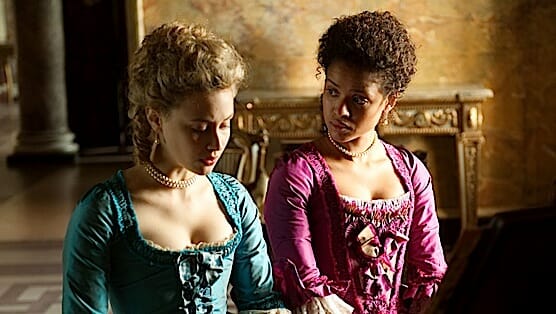Belle

A classily mounted period piece that oscillates between interestingly plotted societal drama and somewhat stuffy and predictable Jane Austen-style handwringing, director Amma Asante’s Belle leans heavily on the unique intrigue that results from a protagonist caught up between different worlds—black and white, rich and disfavored. Never quite content to cast its lot with a grittier and more ambitious tone, this polished and engaging but emotionally gauzy and at times downright frustrating film slugs its way through a lot of dutifully passionate speechifying en route to a conclusion of scrupulously manufactured uplift.
Belle is inspired by the true story of Dido Elizabeth Belle (Gugu Mbatha-Raw), the illegitimate biracial daughter of an 18th century Royal Navy Admiral (Matthew Goode). When her father passes away, Dido is raised in a state of considerable but still arrested privilege by her great-uncle Lord William Murray Mansfield (Tom Wilkinson), the Lord Chief Justice of Great Britain’s highest court, and his wife, Lady Elizabeth Mansfield (Emily Watson). There, Dido lives alongside her cousin and constant companion, Lady Elizabeth Murray (Sarah Gadon), and the unwed Lady Mary Murray (Penelope Wilton), her commingled lineage rendering her too high to eat with servants and too low for dinners with some family guests.
As their mother Lady Ashford (Miranda Richardson) contrives to advance their station, the seemingly charming and quite legitimately smitten Oliver (James Norton) begins to court Dido, while his bigoted brother James (Tom Felton) sets his sights on the younger Elizabeth. Dido, however, is in the unusual position of being “free from the usual inducements to marry,” as Lord Mansfield puts it, because of a monthly pension and inheritance from her deceased father. Still, she finds herself somewhat torn between Oliver, singledom and a young legal apprentice, John Davinier (Sam Reid), whose square-jawed idealism and belief in equality stir in her a sense of both life and love’s greater possibilities.
There’s an interesting tension to Misan Sagay’s screenplay, which, given a relative dearth of concrete information about its protagonist’s life, mixes classically old Hollywood dramatic devices—money marrying money, the requisite love triangle—with more charged material centering around segregation and the brutality of slavery. While the racial elements are handled in mostly patty-cake, work-about fashion (the movie is rated PG), they give Belle the galvanizing electric pop of something fresh and different against this otherwise familiar backdrop.
-

-

-

-

-

-

-

-

-

-

-

-

-

-

-

-

-

-

-

-

-

-

-

-

-

-

-

-

-

-

-

-

-

-

-

-

-

-

-

-








































